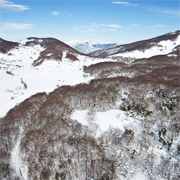
Bosco di Sant’Antonio
The International Carlo Scarpa Prize for Gardens
XXIII Annual Award, 2012
The Jury of the International Carlo Scarpa Prize for Gardens has decided unanimously to dedicate the 2012 cultural campaign, the twenty-third since the Prize was instituted, to the Bosco di Sant’Antonio, an area of wood- and pasture-land in the mountains of Abruzzo near the town of Pescocostanzo.
A bird’s-eye view of the Bosco shows an irregular oblong archipelago of vegetation stretching for about two kilometres along the bottom of a glacier-gouged valley between the south-western spurs of the Maiella massif. It comprises three parts with names that have varied historically but which always refer to a “first hill”, a “second hill” and a “difesa” or “safe haven”. The tree-covered surface of these three portions occupies an area of around a hundred hectares at an altitude of between 1,280 and 1,420 metres a.s.l. and it lies within a sinuous but well-defined boundary line, beyond which spread cultivated farmland fields.
The Bosco di Sant’Antonio features the form, life and dimensions of a wooded pasture, a bosco difesa, quite different from those that characterize a thick, timber-producing forest or shrubby maquis. Its texture, except for some visibly inauthentic areas and despite shortcomings in maintenance, consists of a superb collection of huge mature trees, mainly beech, including some with a monumental candelabra shape that are several centuries old. Thousands of individual specimens – over three thousand were designated for felling and put up for auction in 1952 – relate together within a broad interweave of light and shade, of thickets and clearings, and they have all the features of a space which is lived and governed on a daily basis by man, excluding wild animals of prey and voracious flocks of sheep and goats; shady and undisturbed for horses and oxen in the summer heat; a hospitable environment for a long and varied list of living organisms, some of them especially rare, in the mountain winters.
This place helps us to understand how pastoral-sylvan-agricultural civilizations have contended with the awesome and fearsome forces of nature throughout their history and how they have developed deep-rooted traditions of knowledge and techniques, arts and crafts, management procedures and maintenance practices, temporal and spatial scales to govern them. The Bosco di Sant’Antonio embodies a multi-millenary history of the presence of plant, animal and human life. It is a workshop in which arts and crafts have been developed and practised. It is a place of sequenced daily and seasonal mysteries. It is a lucus of pagan and Christian cults and rites, and in the 1500s the Saint in its name intriguingly mutated from Anthony Abbot to Anthony of Padua.
Text taken from the 2012 Carlo Scarpa Prize Statement, edited by the Jury.
